American troops participated in all the major battles fought in North-Eastern France during the final year of World War One. Numerous monuments and memorials commemorate these engagements as well as the actions by units or individuals.
[ Practical ]
Getting there
- By road
95 km from Paris to Château-Thierry, 145 km till Reims, 260 km till Verdun on autoroute A4.
Suippes is 40 km away from Reims and Argonne 90 km away.
Saint Mihiel is 36 km away from Verdun.
- Train
TER from Paris Gare de l’Est to Château-Thierry (45 mn)
TGV from Paris Gare de l’Est to Reims (45 mn)
TGV from Paris Gare de l’Est to TGV Meuse railway station, then bus to Verdun (1 h 30 mn).
- Getting around
It’s necessary to have a car to reach the battlefields and the monuments.
Hotels
- Château-Thierry
Hôtel Ile-de-France
Hôtel Campanile
- Reims
Hôtel Azur
Hôtel de la Paix
Ibis Centre
Mercure Cathédrale
- Sainte-Menehould
Le Cheval Rouge
- Sommepy-Tahure
La Source du Py
- Verdun
Hostellerie du Coq Hardi
Ibis Budget
- Vienne-le-Château
Le Tulipier
Restaurants
- Château-Thierry
La Symphonie des Saisons
Le Saint-Jean
Hôtel Campanile
- Reims
L’Assiette Champenoise
Le Café du Palais
L’Alambic
- Sainte-Menehould
Le Cheval Rouge
- Sommepy-Tahure
La Source du Py
- Verdun
Le Clapier
Hostellerie du Coq Hardi
- Vienne-le-Château
Le Tulipier
Les Sentiers Scènies de Sommepy-Tahure
Tel : 0326682164
www.sentiers-scenies.com
Centre d’Interprétation de Suippes
Tel : 0326682409
www.marne14-18.fr
Information
- Meuse Tourist Office
Tel : 0329457540
www.tourisme-meuse.com
- Marne Tourist Office
Tel : 0326683752
www.tourisme-en-champagne.com
- Aisne Tourist Office
Tel : 0323277676
www.evasion-aisne.com
If United States entered World War One in 1917, their troops were not engaged in major battles until 1918 as they had to be trained first. Once they were ready, they mainly fought in North Eastern France where they played a decisive role in the final victory. As a result, many WW1 monuments of this region pay homage to the American soldiers.
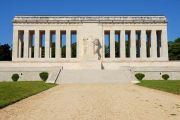
 Hill 204 Monument © T.Joly Hill 204 Monument © T.Joly
|
 Hill 204 Hill 204
The first one is less than 100 km away from the French capital. Known as the Hill 204 Monument, it overlooks the Marne River, Champagne AOC vineyards and the city of Chateau-Thierry. It commemorates the actions by American troops in this sector in June - July 1918 during the Second Battle of the Marne, in particular the re-capture of Chateau-Thierry on June 3-4. Consisting of a double colonnade, it is adorned with statues representing United Sates and France as well as with an eagle and a map of the military operations that took place in the region.
A bit further away from the valley, are the village of Belleau and the wood where US Marines got their first real taste of battle in WW1 and established their reputation for bravery. Dubbed by General Pershing as the most important battle fought by US forces since the Civil War, it brought to an end the last major German offensive of the war.
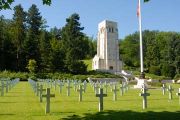
 Belleau American cemetary © T.Joly Belleau American cemetary © T.Joly
|
 Belleau Wood Belleau Wood
Fiercely defended, the wood was first taken by the Second Division's Marine Corps, under James Harbord, then ceded back to the Germans - and again taken by the U.S. forces a total of six times before the Germans were finally expelled. The battle ran from 6-26 June and by its end US Marine casualties were the highest in the Corp’s history up to that date. To clear the woods in their entirety, the Marines had frequently resorted to hand-to-hand fighting with bayonets and knives. Such was the ferocity of this that the Germans gave them the nickname “Teufel Hunden”, which roughly translates as “Devil Dogs”. Hence the tradition of using an English bulldog as a mascot for the Marine Corps. Stretching around a little chapel, the Belleau Wood chapel cemetery holds the remains of 2,300 American soldiers and In the village itself, a small museum gives information about the battle.

 Devil Dog fountain © T.Joly Devil Dog fountain © T.Joly
|
 Devil Dog fountain Devil Dog fountain
Sometimes, the caretaker takes visitors to the famed "Devil Dog" fountain located in a private courtyard adjoining the stables of the Countess of Belleau’s estate. Legend has it that any U.S. Marine who drinks from this fountain will have an additional 20 years added to his life !! But it was in fact built before the war.
About 30 km North East, in Féré-en-Tardenois, is another American Cemetary that holds the remains of 6,012 American war dead, most of whom lost their lives while fighting in this vicinity in 1918. Nearby in Oulchy-le-Château, a moving sculpture by Paul Landowski honors all the allied units that participated in this battle. Called “The Ghosts”, it stands on the Butte Chalmont.
Also in the same area, in the hamlet of Chamery, near Coulonges-Cohan, is a memorial fountain paying homage to Quentin Roosevelt who was killed in aerial combat on July 14.
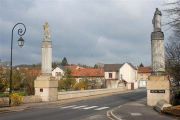
 Fismes Memorial Bridge © T.Joly Fismes Memorial Bridge © T.Joly
|
 Fismes Memorial Bridge Fismes Memorial Bridge
It was built on behalf of her mother who also placed a marble slab on the exact spot where Germans soldiers first buried the youngest son of president Theodore Roosevelt.
A few km further North you reach Fismes where the State of Pennsylvania erected a memorial bridge bearing lanterns to honor the dead as well as statues of Liberty and Peace which commemorates the recapture of the town by the 28th US Division in August – September 1918. A unit that may at one time have been commanded by General Custer, which would explain the engravings of buffalos decorating the base of the lanterns !!!
4 km away, in Courville, in a region where abbeys abound, a fountain was built by William Russel's family, a pilot who died in August, 1918 and is buried in the village cemetery.
You are now in the Marne department, one of the main battlefields of the conflict and, in Mondement, South of Epernay, a 35 m high ochre concrete standing stone marks the extreme point reached by the Germans during the First Battle of the Marne, in 1914.
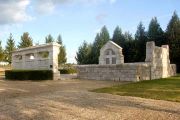
 Farnsworth Monument © T.Joly Farnsworth Monument © T.Joly
|
 American legionnaires American legionnaires
At that time, there were no US troops but American volunteers quickly started to join the French Army and in the Suippes military camp there is a monument set up by an American family in memory of their son Henry Farnsworth and his legionnaire comrades who died in the 1915 fighting.
Your only chance to see it is on November 11th. On the occasion of the celebration of the Armistice, the military camp is indeed sometimes exceptionally open to the public who can also discover the ruins of villages destroyed during that war and never rebuilt.
In the village of Suippes, a very interesting Center of Interpretation presents all the armies of the Nations that participated in the battles in the region while giving instructive explanations about the evolutions of the front and the weapons used.
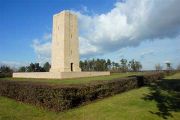
 Blanc Mont Ridge © T.Joly Blanc Mont Ridge © T.Joly
|
 Blanc Mont Ridge Blanc Mont Ridge
Always in the same sector, there once stood a farm called Navarin. Being right in the middle of the front line for months it was razed to the ground and now, on the same spot, rises an ossuary bearing the same name which shelters the remains of 10 000 fighters. It is topped by three soldier’s sculptures and the right one featuring a man armed with a machine gun has the face of the aviator Quentin Roosevelt. Another one portrays General Gouraud who commanded this sector and now rests in the crypt of the monument as he asked to be buried with his men.
In fall of 1918, the German lines were penetrated and American troops headed North. Sometimes at the price of heavy casualties like at Blanc Mont ridge, near Sommepy-Tahure where there is now a cemetery and a memorial in their honor. From its summit there is an excellent view over the battlefield and it’s still possible to make out the former German trenches.

 Freddy Stowers stelei © T.Joly Freddy Stowers stelei © T.Joly
|
 Freddy Stowers’ heroic conduct Freddy Stowers’ heroic conduct
From September 26 to November 11, the American troops also led big offensives that led to victory in Argonne, a rugged and woody region stretching over three departments : the North-East of the Marne, the South-East of the Ardennes and the North-West of the Meuse.
On the territory of Grateuil, in Marne, near the farm of Bussy, a simple stele in the middle of the fields reminds visitors of the heroism of corporal Freddy Stowers, who in 1991, posthumously became the only Black American soldier of the First World War, to have received the Medal of Honor, the United States’ highest military distinction.
It was the survivors of his unit, the 371st Regiment of Infantry, who paid for this stele in memory of this man and his companions who died on September 28th.
Violent fighting had already taken place in this area at the beginning of the war and it had been well strengthened by the Germans as shown by the camp of the Vallée Moreau, North of Vienne-le-Château, in the wood of Gruerie.
 Lost Batallion Lost Batallion
Half buried in a hill, as a protection against shelling, it was restored by volunteers and constitutes an almost unique example of a fortified camp. Also well worth a look is the Kaiser Tunnel, a network of 455 m of subterranean galleries dug by the Germans which sheltered a hospital, a power plant and a telephone exchange. A little further on, between Blainville and Charlevaux, a boundary stone standing on the right of the road indicates the valley where eight units of the 77th American Infantry Division were surrounded by the Germans for several days and lost most of their men. The famous episode of the Lost Batallion, that took place early October and was immortalized by a film as early as 1919.
A few km to the North, in Ardennes, is the place where Sergeant Alvin York became one of the most well known heroes of the United States.
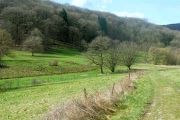
 Surroundings of Chatel-Chehery © T.Joly Surroundings of Chatel-Chehery © T.Joly
|
 Sergeant York Sergeant York
It was just beside the village of Chatel-Chehery where a commemorative plaque dedicated to him stands in front of the city hall, in what is now a peaceful hilly landscape that, on October 8th, this native of Tennessee led an attack during which 32 machine guns and 132 Germans were captured. An exploit which led to him becoming the most decorated American soldier of the First World War; a 1941film starring Gary Cooper tells his story.
Fifteen km away, in the Meuse department, Romagne-sous-Montfaucon is home to Europe’s largest American military cemetery with 14 246 soldiers buried in its compound including Freddy Stowers.
Nearby, in Montfaucon d' Argonne, a monument dominated by a more than 60 m high Doric column topped by a statue of Liberty commemorates the American offensive.
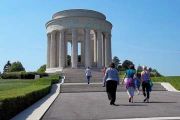
 Montsec Monument © T.Joly Montsec Monument © T.Joly
|
 Salient of Saint-Mihiel Salient of Saint-Mihiel
Before that, many US units engaged in Argonne had fought further East, in the vicinity of Verdun, site of the most famous battle of the War. More exactly south of this city, where American troops commanded by General John Pershing were given the mission to reduce the salient of Saint-Mihiel in September. It was the AEF's first major offensive operation as an independent army during WW1, as well as the first time the U.S used tanks in battle and Colonel Patton was in command of the light-tank brigade. The United States Army Air Service - which later became the US Air Force - played a significant role and it is also said that this battle marked the first use of the terms 'D-Day' and 'H-Hour'.
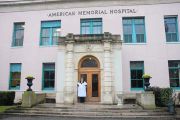
 Reiims American Hospital © T.Joly Reiims American Hospital © T.Joly
|
 Donations for the reconstruction Donations for the reconstruction
A commemorative monument by architect Egerton Swartout stands on Montsec hill and overlooks the plain while an American cemetery where more than 4,000 soldiers rest in peace is located near the village of Thiaucourt.
But the assistance of the United States to France continued after the end of the war. In Marne, the village of Sommepy was reconstructed thanks to donations that one of its inhabitants, Lieutenant Lhuillier went to collect in several East Coast States by giving speeches. In the city hall, a small museum retells this story and every summer a nocturnal audio video walk through the village depicts its history and that of its inhabitants before, during and after the war. Another example is the hospital for the children of Reims which was built in the 20s thanks to American funds. The names of the donors can still be seen on the walls of the rooms that are, for some of them, adorned with as the original frescoes.
November 28, 2012
Thierry Joly 

|



